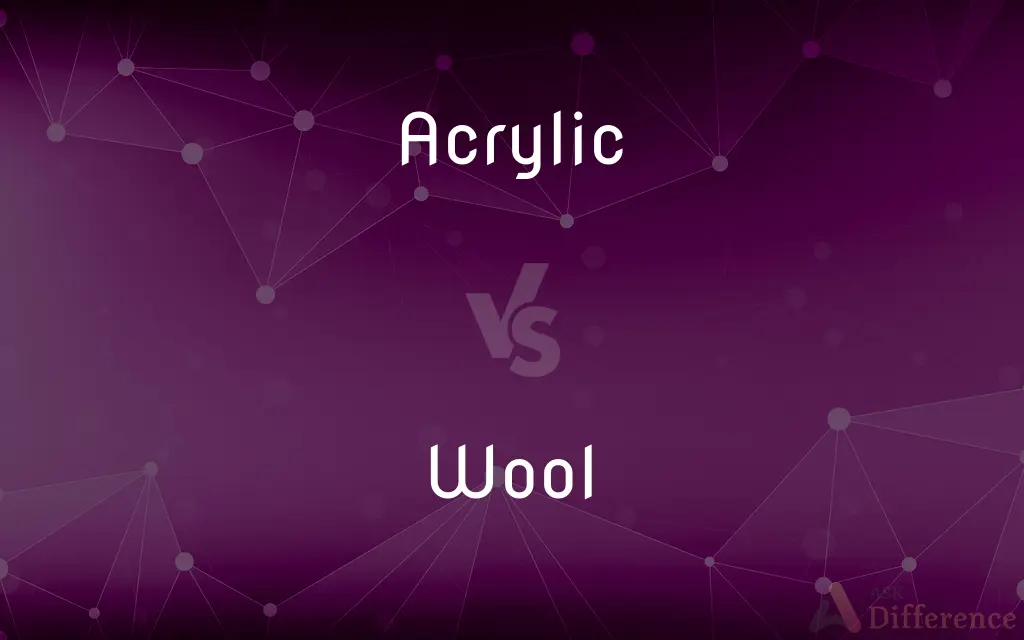Acrylic vs. Wool — What's the Difference?
By Fiza Rafique & Urooj Arif — Updated on March 21, 2024
Acrylic is a synthetic fiber known for its durability and ease of care, often used as a wool substitute, while wool is a natural fiber prized for its warmth, breathability, and natural elasticity.

Difference Between Acrylic and Wool
Table of Contents
ADVERTISEMENT
Key Differences
Acrylic fibers are man-made, designed to mimic wool's warmth and texture but at a lower cost and with greater resistance to wear and tear. Wool, on the other hand, is a natural fiber obtained from sheep and other animals, offering superior warmth, breathability, and moisture-wicking properties.
In terms of care, acrylic is highly durable, resistant to moths, mildew, and sunlight, and can often be machine washed and dried, making it a low-maintenance option. Wool requires more careful handling, including cold water washing and air drying, to prevent shrinking and damage.
Acrylic offers a wide range of colors and is less likely to fade over time due to its synthetic nature. Wool, while also available in various colors, may fade with repeated washing or exposure to sunlight, but it offers the unique advantage of being dyeable in its natural state.
Wool's natural elasticity allows it to stretch and return to its original shape, making wool garments comfortable, durable, and resistant to wrinkles. Acrylic, while stretchable, may not always return to its original shape as easily, potentially leading to sagging or distortion over time.
Environmental impact is another consideration; acrylic is petroleum-based and may contribute to microplastic pollution, whereas wool is renewable and biodegradable, but its production involves animal farming, which has its own environmental and ethical considerations.
ADVERTISEMENT
Comparison Chart
Origin
Synthetic, petroleum-based
Natural, animal fiber (primarily sheep)
Durability
High, resistant to wear and tear
High, but can be prone to moth damage
Care & Maintenance
Easy, often machine washable
Requires careful handling, prone to shrinkage
Warmth & Breathability
Warm, less breathable than wool
Superior warmth and breathability
Moisture Wicking
Lower moisture wicking than wool
Natural moisture-wicking properties
Elasticity
Less likely to retain original shape
High elasticity, retains shape well
Environmental Impact
Contributes to microplastic pollution
Renewable and biodegradable, but requires animal farming
Cost
Generally less expensive
Can be more expensive, varies by quality
Color & Fade Resistance
High color retention, resistant to fading
Natural dyes may fade but can be more vibrant initially
Compare with Definitions
Acrylic
Often used in affordable, colorful knitwear.
The artist chose bright acrylic yarns for the community mural.
Wool
Requires careful maintenance to avoid shrinking.
She hand-washed her wool sweater in cold water to maintain its size.
Acrylic
Resistant to moths and mildew, ideal for easy-care garments.
Her acrylic blanket stored well over summer without damage.
Wool
A natural, breathable fiber known for its warmth.
Her wool coat kept her warm through the winter storm.
Acrylic
Contributes to microplastic pollution, raising environmental concerns.
Researchers are studying how washing acrylic clothing affects water quality.
Wool
Elastic and durable, making it ideal for heirloom-quality garments.
The hand-knitted wool scarf passed down through generations still looked new.
Acrylic
A durable, synthetic fiber offering wool-like warmth.
The acrylic sweater remained vibrant and soft after many washes.
Wool
Renewable and biodegradable but involves animal farming.
They sourced wool from ethically raised sheep for their eco-conscious clothing line.
Acrylic
Suitable for people with wool allergies.
He wore an acrylic hat because of his sensitivity to wool.
Wool
Offers natural moisture-wicking and odor resistance.
The hiker preferred wool socks to keep his feet dry and fresh.
Acrylic
(of synthetic resins and textile fibres) made from polymers of acrylic acid or acrylates
A red acrylic jumper
Wool
Wool is the textile fibre obtained from sheep and other animals, including cashmere and mohair from goats, qiviut from muskoxen, hide and fur clothing from bison, angora from rabbits, and other types of wool from camelids.Wool consists of protein together with a small percentage of lipids. In this regard it is chemically quite distinct from the more dominant textile, cotton, which is mainly cellulose.
Acrylic
An acrylic textile fibre
A sweater in four-ply acrylic
Wool
The fine, soft curly or wavy hair forming the coat of a sheep, goat, or similar animal, especially when shorn and prepared for use in making cloth or yarn
Harris tweed is made from pure new wool
Acrylic
An acrylic paint
Washes of white acrylic
She paints mainly in acrylics
Wool
The dense, soft, often curly hair forming the coat of sheep and certain other mammals, such as the goat and alpaca, consisting of cylindrical strands of keratin covered by minute overlapping scales and much valued as a textile fiber.
Acrylic
An acrylic resin.
Wool
Fabric or yarn made of this hair.
Acrylic
A paint containing acrylic resin.
Wool
Hairy or downy material on a plant or animal, as on certain caterpillars.
Acrylic
A painting done in acrylic resin.
Wool
Filamentous or fibrous material similar to the wool of a sheep or other mammal.
Acrylic
Any of numerous synthetic fibers polymerized from acrylonitrile.
Wool
The hair of the sheep, llama and some other ruminants.
Acrylic
(organic chemistry) Derived from acrylic acid or acrylonitrile.
Wool
A cloth or yarn made from the wool of sheep.
Acrylic
Containing an acrylic resin.
Wool
Anything with a texture like that of wool.
Acrylic
(organic chemistry) An acrylic resin.
Wool
A fine fiber obtained from the leaves of certain trees, such as firs and pines.
Acrylic
(painting) A paint containing an acrylic resin.
When it comes to painting, I prefer using acrylics as my medium.
Wool
(obsolete) Short, thick hair, especially when crisped or curled.
Acrylic
A painting executed using such a paint.
Wool
Yarn, including that made from synthetic fibers.
Acrylic
A thick sheet of plastic.
Wool
A resident of a satellite town outside Liverpool, such as St Helens or Warrington. See also Yonner.
Acrylic
A liquid coating system based on an acrylic resin.
Wool
The soft and curled, or crisped, species of hair which grows on sheep and some other animals, and which in fineness sometimes approaches to fur; - chiefly applied to the fleecy coat of the sheep, which constitutes a most essential material of clothing in all cold and temperate climates.
Acrylic
Of or containing acryl, the hypothetical radical of which acrolein is the hydride; as, acrylic acid. The characteristic residue in an acrylic compound is the carbonyl group attached directly to an ethylenic carbon.
Wool
Short, thick hair, especially when crisped or curled.
Wool of bat and tongue of dog.
Acrylic
Same as acrylic resin.
Wool
A sort of pubescence, or a clothing of dense, curling hairs on the surface of certain plants.
Acrylic
Same as acrylic fiber.
Wool
A fabric made from the hair of sheep
Acrylic
A paint in which the pigment is suspended in a solution of an acrylic resin, which dries to a hard film on exposure to air.
Wool
Fiber sheared from animals (such as sheep) and twisted into yarn for weaving
Acrylic
A painting made using an acrylic paint.
Wool
Outer coat of especially sheep and yaks
Acrylic
Polymerized from acrylonitrile
Acrylic
A glassy thermoplastic; can be cast and molded or used in coatings and adhesives
Acrylic
Used especially by artists
Acrylic
A synthetic fabric
Common Curiosities
How does the environmental impact of acrylic compare to wool?
Acrylic contributes to microplastic pollution, whereas wool is renewable and biodegradable but involves animal farming, which has its own environmental footprint.
Are there any care tips for wool garments to prevent damage?
Wool garments should be washed in cold water, preferably by hand, and laid flat to dry to prevent shrinking and maintain their shape.
Can acrylic and wool be blended together?
Yes, blending acrylic and wool combines the durability and ease of care of acrylic with the warmth and natural feel of wool.
How do cost differences between acrylic and wool affect consumer choices?
Cost differences often lead consumers to choose acrylic for budget-friendly options, while wool may be preferred for investment in higher-quality, sustainable garments.
What is the significance of wool's natural elasticity?
Wool's elasticity means it can stretch without breaking and return to its original shape, enhancing the comfort and durability of garments.
How do synthetic alternatives to wool compare in terms of performance?
Synthetic alternatives, like acrylic, aim to mimic wool's warmth and texture but often fall short in breathability, moisture management, and environmental impact.
What are some ethical considerations in wool production?
Ethical considerations include animal welfare practices, sustainable farming, and the treatment of workers in the wool industry.
What are the main advantages of acrylic over wool?
Acrylic is more affordable, easier to care for, and hypoallergenic compared to wool.
Why is wool considered more breathable than acrylic?
Wool's natural fibers provide superior air circulation and moisture-wicking, which helps regulate temperature and reduce sweat buildup.
Is wool always itchy?
Not all wool is itchy; finer grades of wool, like merino, are much softer and less likely to irritate the skin.
Why might someone prefer wool to acrylic?
Wool is preferred for its natural warmth, breathability, moisture-wicking properties, and environmental sustainability.
Can wool garments be treated to reduce their tendency to shrink?
Yes, some wool garments are treated with a process called "superwash," making them more resistant to shrinking and easier to care for.
What is the impact of washing acrylic garments on the environment?
Washing acrylic garments can release microplastics into waterways, contributing to pollution and affecting aquatic life.
Can acrylic be recycled?
Acrylic can be recycled, but the process is less common and more complex than recycling natural fibers like wool.
Are there hypoallergenic options for wool-sensitive individuals?
For those sensitive to wool, hypoallergenic options include fine merino wool, which is softer and less likely to cause irritation, or synthetic fibers like acrylic.
Share Your Discovery

Previous Comparison
Beefburger vs. Hamburger
Next Comparison
Guts vs. GutAuthor Spotlight
Written by
Fiza RafiqueFiza Rafique is a skilled content writer at AskDifference.com, where she meticulously refines and enhances written pieces. Drawing from her vast editorial expertise, Fiza ensures clarity, accuracy, and precision in every article. Passionate about language, she continually seeks to elevate the quality of content for readers worldwide.
Co-written by
Urooj ArifUrooj is a skilled content writer at Ask Difference, known for her exceptional ability to simplify complex topics into engaging and informative content. With a passion for research and a flair for clear, concise writing, she consistently delivers articles that resonate with our diverse audience.














































